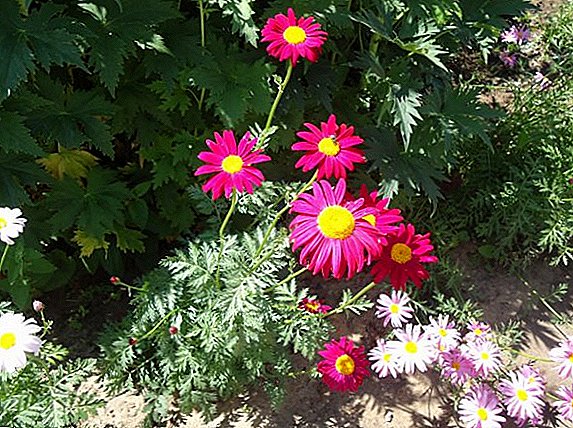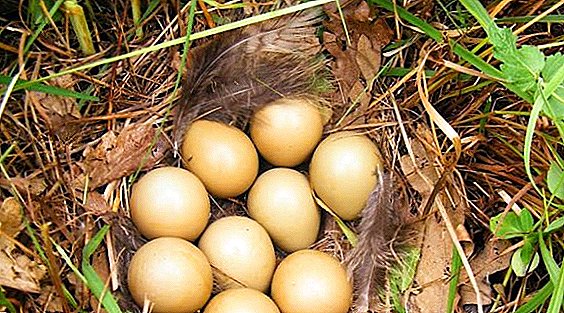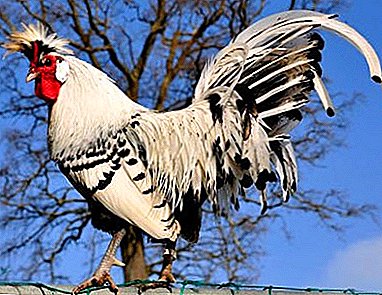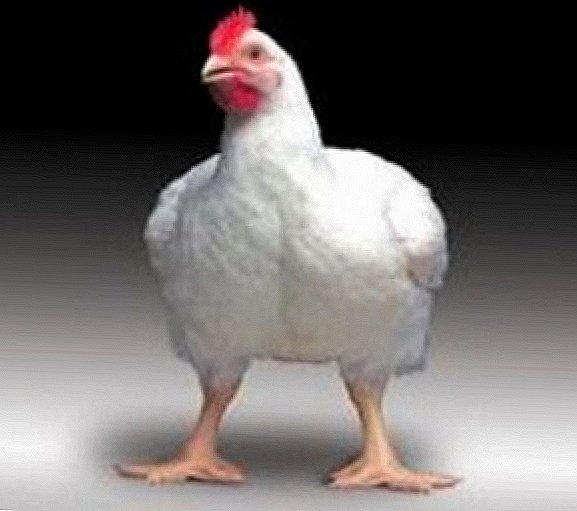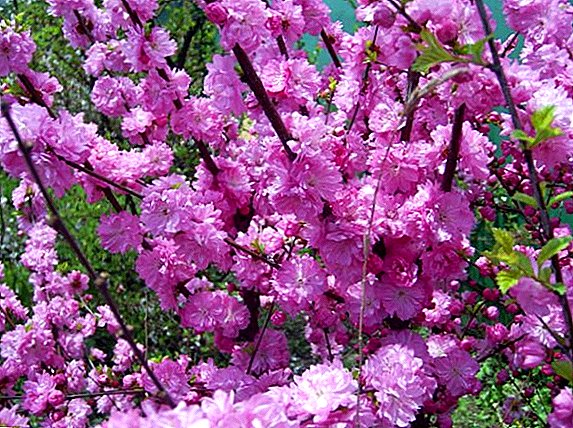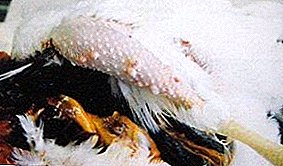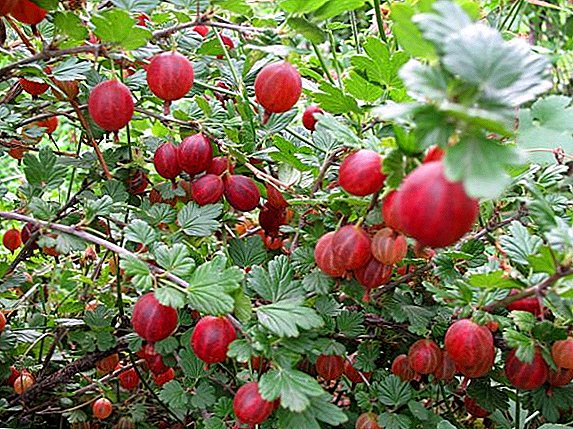 Apple trees remain the most popular among fruit trees. Despite the emergence of new varieties, many prefer them proven local lines.
Apple trees remain the most popular among fruit trees. Despite the emergence of new varieties, many prefer them proven local lines.
About one of these will tell in this review. Consider the interesting apple tree "Papirovka", how it is made planting and care.
Breeding history
The variety is considered popular - it appeared as a result of natural pollination, and it became famous at the beginning of the 19th century.
It is believed that the habitat of the apple is the Baltic States, from where the line spread to Poland, Germany, Ukraine and the west of Russia. In addition to the official name, the variety is also called "Alabaster" or "Baltic."  Many take this tree and fruit for "white filling." They are really similar, but there is still no consensus. Meanwhile, even I. V. Michurin pointed out the differences.
Many take this tree and fruit for "white filling." They are really similar, but there is still no consensus. Meanwhile, even I. V. Michurin pointed out the differences.
If you think about what “Papirovka” and “White filling” are, it will become clear how they differ. The first one has more conical fruits, they are juicy and more acidic. Blush on them is not, and ripen for 2 weeks later, "white hair". The trees are less hardy, but there is almost no scab on them.
Check out such apple varieties as Medunitsa, Spartan, Candy, Bogatyr, Lobo, Pepin saffron, Melba, Zhigulevskoe, Mechta, and Currency.
Biological features
Consider what is a tree and its fruits.
Tree description
The tree is medium. At a young age, the crown resembles a pyramid, with time it becomes more rounded. Skeletal branches covered with light gray bark. Oval leaves - medium, green-gray, with raised tips.  The first crops are formed on short shoots (3-4 cm) with weak lateral buds. Gradually they become strong fruit branches.
The first crops are formed on short shoots (3-4 cm) with weak lateral buds. Gradually they become strong fruit branches.
Important! Before planting a young seedling, prepare a strong peg that will hold the trunk.Middle-sized shoots are heavily pubescent, with olive-brown bark. Vegetative buds are small and flat, gray in color. Rose buds are large. Petals on flowers are more often white, sometimes they come across with a pink shade.
Fruit Description
Apples are average in weight (usually 80-120 g). On young trees can grow and more weighty - in 130-180 g.
They are all round, sometimes conical in shape, with a green-yellow color. The skin is thin and smooth, with a thick coating of wax. When fully mature, it turns white.
Delicate flesh of white color is sweet and sour. The core resembles an onion, with light brown granules of irregular shape. 
Pollination
Large flowers attract many insects, so there are no problems with pollination.
Did you know? The legendary I. V. Michurin became the author of 9 varieties of apples. The “donor” for some of them was the “Kitayka” variety, known in our area since time immemorial.For greater effect, cross-pollination is used. The best neighbors for "Papirovka" are varieties "Anis Scarlet" and "Borovinka".
Gestation period
Summer-grade trees begin to bear fruit in the 3-5th year after planting. In some regions, apples appear on the 6th year (it depends on the weather conditions in the region).
After this period, the fruits ripen by the last decade of July or in the first days of August. 
Yield
The variety is considered high-yielding. 50-75 kg of apples are removed from a 10-year-old tree.
Fruiting continues for 40-55 years, it can be called stable. But there are some nuances: for example, after a bountiful harvest, the harvest for the next year will be smaller. It happens that it is not at all - the tree took a "breather", or the weather let it down.
As the tree ages, yields gradually decrease.
Important! Use only manure for fertilizer. Fresh contains a lot of hydrogen sulfide and ammonia, which can "burn" immature roots.
Transportability and storage
The fruits have a clear advantage - with proper watering, they do not fall off. But with transportation and storage is more difficult.  The delicate skin is very sensitive to damage, and the appearance of the product after a long "trip" is almost not preserved - the transportability is low. And if dark spots are visible on apples, there is a risk of rapid decay.
The delicate skin is very sensitive to damage, and the appearance of the product after a long "trip" is almost not preserved - the transportability is low. And if dark spots are visible on apples, there is a risk of rapid decay.
The optimal shelf life is 1 month. Then the fruits lose their taste and nutritional qualities. For a long time to keep them in the refrigerator is also undesirable - there is a “loss” in 2-3 weeks.
Winter hardiness
"Papirovka" tolerates winter. Small frosts in the belt of temperate climate do not cause special harm to trees.
As a safety net, the lower part of the trunk is warmed, and the under-barrel circle is covered with mulch. This is true for the northern regions.
Disease and Pest Resistance
The variety pleases with good resistance to diseases and pests. True, prolonged severe frosts or prolonged droughts reduce the immunity of the apple tree. Do not forget about the neighbors - the sore can migrate from the already affected tree nearby.  Pests are often attracted to the bark, not the fruit, so the trunk and crown must be protected in autumn.
Pests are often attracted to the bark, not the fruit, so the trunk and crown must be protected in autumn.
It will be useful for you to learn about the main pests of the apple tree.
Application
Juicy and quickly softening apples are ideal for making juice. They can also be added to various jams and mixes in the form of jam from different fruits and berries.
How to choose seedlings when buying
Before buying the apple tree "Papirovka" you should once again read the description and see the photos of this variety, but rather ask about the reviews of gardeners who grow this variety. Choosing a sapling, remember these points:
- Keep an eye on the roots. They must be whole, wet and at the same time kept in a clump of soil. Dry, broken and bare are excluded.
Did you know? Surprisingly, the apple gave the name ... an orange! Having first seen this fruit in China, Dutch sailors took it for a local apple, calling it apfelsine.
- On the roots should not be blistering and painful growths. Healthy processes are always white in the cut. If the brown color catches the eye - the seedling is already frozen.
- Better to take a one-year-old apple tree. There are no developed branches on it, and the tree will be better accepted at the site.
- Health stalks. If, having crunched the bark, you saw a bright green scratch, then everything is normal.
- The integrity of the trunk. In a normally grafted tree, it will not fall off.
Rules for planting apple seedlings
Agrotechnology is familiar to experienced gardeners, but for beginners it sometimes remains a mystery. We will solve it together, considering the procedure of landing in detail.
Optimal timing
"Paps" are planted in late March - the first half of April. These terms may slightly shift (for 1, maximum 2 weeks) if there is a probability of repeated frosts.
Choosing a place
For planting select a smooth, well-lit area with established drainage - the water should not stand for a long time. The depth of groundwater - at least 1 m (preferably occurring up to 1.5).
Important! Sour soils "improve", evenly introducing humus to the site. On 1 square. m takes 200-800 g of material, depending on the condition of the soil.Sapling trying to place near other apple trees at a distance of 4-5 m.

Site preparation
In the designated area, remove all debris and remove old roots. By necessity, the soil is leveled, knocking the hillocks or falling asleep the old grooves. Light loam is considered the ideal soil, but other types are suitable (except for highly saline lands).
A week before the intended landing, a hole is dug (up to 90 cm), at the bottom of which a fertilizer is laid. On a bucket of humus (10 l) take 1 kg of "mineral water" and 750 g of wood ash, stir and fall asleep on the bottom. In this case, place the top layer of soil separately (pouring in a heap on one side of the hole).
Seedlings preparation
Carefully inspect the seedlings, paying special attention to the roots. Try to moisten the fibrous roots during storage - growth depends on them.
Did you know? Green apples compare favorably with their red "brethren" by a much higher content of vitamin C.Another old method is known. Mullein and clay mixed until smooth and pour water. In this mixture and lower the roots, after which they are a little dried. Now drying is not scary. The day before planting, the roots are placed in water (from 4 hours to days). Of course, you should not sharply pull the apple tree - damage to anything.
Process and scheme
The landing itself looks like this:
- Land in the hole is thoroughly loosened (on a spade bayonet).
- Deferred topsoil is mixed with chopped peat or manure. Add superphosphate (250 g) or 350 g of ash. All this goes into the pit, they fall asleep by 2/3.
- Sapling put to a peg so that the height of the root collar from the ground was about 5-6 cm.
- The roots are bred on the sides and sprinkled with the remnants of the soil, not forgetting to seal the legs.
- Barrel tied to a peg.
- It remains to do the hole and pour abundantly (3-4 buckets). You can sprinkle with mulch (3-5 cm), suitable straw, peat or humus.

Features of seasonal care for apple trees
Caring for trees throughout the year can be divided into three stages: spring, summer and autumn. Each of them provides its own types of work. Select them in general terms.
Spring care comes down to:
- inspection;
- treatment of wounds and other damage;
- pruning diseased or broken branches;
- feeding the apple tree.
Important! Some use old rags like mulch. This is practical, but in the hot summer it is not particularly effective - they have to be removed so that the roots can “breathe”.In the summer, such procedures are added as:
- timely watering;
- spraying and treatment of diseases.
- the tree is fed;
- be sure to whiten the trunk;
- if necessary, additionally sprayed from pests.

Soil care
This variety is very picky about moisture and does not tolerate drought. Therefore, the "Pap" has to be watered often and plentifully. For areas with a temperate climate, a one-year-old seedling of 2-3 buckets per tree with an interval of 10-12 days will suffice. In more arid regions, the same amount of water must be added weekly.
If you put the "rain", it will take about 2 hours.
Did you know? Japanese Chisato Ivasagi in 2005 grew the largest apple - the fruit has hung 1,849 kg. True, this was preceded by a 20-year job, including control over crossing.For trees of 3 years, the interval between watering is slightly reduced, they no longer need liquid as young ones.
The final, prewinter watering is obligatory for areas where no permanent fillings were made in the summer. In late October - early November, on 1 square. m pristvolny circle take 80-100 liters of water. For trees that are well hydrated in the summer, you can take a smaller volume - it only hardens the apple tree.  Weeding is traditional - we remove the weeds as they appear, not letting them take root.
Weeding is traditional - we remove the weeds as they appear, not letting them take root.
The same applies to loosening: circles will have to fluff after each watering. Roots should receive not only moisture, but also air, so try to prevent the appearance of a "crust".
The type of mulch depends on the purpose of its use. Moisture retains small bark (layer 5 cm), which can be put after the first watering. In order not to overheat the soil, sawdust is being poured, up to 7 cm. Moss, on the contrary, is laid for warming up - 10 cm is enough.
Fertilization
Unpretentious apple tree enough 2-3 “feed” for the season.
Important! The composition for whitewashing is prepared as follows: in 2 liters of water add 300 g of lime and 2 tbsp. l clerical glue, all mixed to a whole mass. But for year-old trees it will be enough to bring a small crayon.The first feeding is made immediately after the winter "hibernation". 550 g of urea and nitroammophoska (no more than 40 g) are added to 4-5 buckets of humus. All this pour in circles for digging.
 The next approach is the flowering period. 250 g of urea and 0.5 l of slurry are poured into 2 liters of liquid chicken manure. There is also superphosphate with potassium sulfate (100 and 65 g each). 3-4 buckets of such a "mix" are brought under one tree, having calculated the proportion.
The next approach is the flowering period. 250 g of urea and 0.5 l of slurry are poured into 2 liters of liquid chicken manure. There is also superphosphate with potassium sulfate (100 and 65 g each). 3-4 buckets of such a "mix" are brought under one tree, having calculated the proportion.In the autumn, urea solution is poured (750 g / 10 l of water). Recall that liquid fertilizers are applied in dry weather, with a high humidity they take dry solutions, sprinkling circles on them.
Fight against crown diseases and pests
No tree is insured against diseases of the bark, leaves and flowers. Therefore, gardeners have to deal with them.
Fungal diseases like powdery mildew, milky luster and scab are easy to overcome. The pathogens that carry them out do not tolerate periodic disinfection.  If the problem arose before flowering, add 10 liters of urea to 10 liters of water and spray the crowns. In the later stages of the growing season, soda ash is taken for processing (75 g for the same volume).
If the problem arose before flowering, add 10 liters of urea to 10 liters of water and spray the crowns. In the later stages of the growing season, soda ash is taken for processing (75 g for the same volume).
With deep lesions (burns, cytosporosis, cancer of the cortex) is more complicated. Sick branches are removed, and the cut points are smeared with brilliant green or linseed oil, garden varieties are also suitable.
Attacks pests "repel" such compounds:
- Apple blossoms splash with "Fufanon" (10 ml / 10 l of water) or "Karbofos" (90 g). A fruit tree has enough 5 l of solution, and a young one - 2 l. After 2-3 weeks, the treatment is repeated.
Did you know? The apple flower is the official symbol of the state of Michigan.
- Listovertka does not tolerate "Nitrofen" (200 g / 10 l). In early spring they spray the soil under the tree.
- Having found the aphids, they remove the diseased bark and splash the branches with "Fufanon" or "Ditox", stirring according to the instructions.
- The same drugs help and from ticks.
 Many reluctantly use "chemistry". There is also a natural product: chamomile infusion. 200 g of ground flowers are taken on a bucket of water. Infusing 12 hours, the liquid is decanted. The infusion is ready.
Many reluctantly use "chemistry". There is also a natural product: chamomile infusion. 200 g of ground flowers are taken on a bucket of water. Infusing 12 hours, the liquid is decanted. The infusion is ready.Cropping and crown formation
Much depends on the formative trim in the first 2 years. At first pruning, the strongest skeletal branches are left. On the other side of the trunk, approximately at the same level with them, there may be so-called competitors growing at an acute angle. They are removed.
Important! Trees with a height of 4 meters or more reduce this figure. It is inconvenient to work with the "giants" - not every sprayer will reach the upper branches, and it is unrealistic to remove the fruits from them.The medium-sized branches are cut by a third, and the side branches are brought under one level. The lower ones are cut slightly, processing the upper ones more. To get involved in cutting young sapling is not worth it, so as not to harm.
After the "Papirovka" began to bear fruit, carry out regulatory pruning. Everything is simple here - annually, even before flowering, free the crown from unnecessary branches. This sort of such appears only a few pieces, and the procedure does not make much effort. Such apples are not predisposed to thickening. Young branches are shortened by 1, maximum 2 buds, no more.
Sick branches are removed immediately, regardless of age.
Learn about the best tips for pruning apple trees.Mature trees need rejuvenating pruning. Branches are cut that do not grow themselves and interfere with the fruitful ones. Those areas where there was a weak annual growth (10-15 cm) were removed, leaving the places that appeared during normal growth (from 25 cm per year).
This is not a one-time action - such “operations” with old apple trees occur for several years in a row.
Protection against cold and rodents
After autumn whitewashing and dressing trees are prepared for frost. Circles intensively mulch (a thick layer twice). 
The barrel can be covered with almost any material, but is best suited:
- old rags;
- roofing material or roofing felt;
- bags;
Did you know? Among the trees, too, there are "long-livers". One of them is an apple tree, planted as early as 1647. She was landed by Peter Stuvesant, and she is still growing in Manhattan.
- cellophane will also fit. But he, like roofing felt, will have to be removed during the first thaw so that the barrel does not suffocate;
- Traditional "windings" of reeds, straw, or spruce are also useful, but such shelter can attract pests looking for a place to winter.
By the way, about "toothy". They will not harm if the apple tree is covered with a “non-wrap” or nylon stockings. They can cover branches and stamps. The same effect will be from spruce legs, wrapped around the trunk with needles downwards.  Mice do not tolerate blue vitriol. 100 g per 10 l of water, sprinkle 2 l per young sapling and 10 l per adult tree. Doing such work in November will save your fruit for the future. The same effect in 1% Bordeaux liquid.
Mice do not tolerate blue vitriol. 100 g per 10 l of water, sprinkle 2 l per young sapling and 10 l per adult tree. Doing such work in November will save your fruit for the future. The same effect in 1% Bordeaux liquid.
The surest method to protect plantings from large hares is to plant a fine grid of great height along a circle that has been dug up. True, for an unguarded dacha this is not the best option - already two-legged “pests” can drag off the fence.
Important! Some densely ram snow around a tree, thereby depriving voles of the ability to move. On the other hand, it is laborious - it is necessary to compact the layer after each snowfall.The budget option - a few large circles, cut out of black cardboard. They scare eared.
Hopefully now the apple tree of the sort "Papirovka" does not represent a special secret for our readers. As you can see, the most common care, but regular. Successes in the garden!


